|
| |
| |

| Feel better today. Stay healthy for tomorrow | Make smart choices from every food group. | Mix up your choices within each food group.| Find your balance between food and physical activity. | Get the most nutrition out of your calories. | NUTRITION: To know the facts? | How to use the label. | Play it safe with food. | About alcohol. |
Here's how: The food and physical activity choices you make every day affect your health? how you feel today, tomorrow, and in the future. The science-based advice in this article highlights how to:
Make smart choices from every food group.
Find your balance between food and physical activity.
Get the most nutrition out of your calories.
You may be eating plenty of food, but not eating the right foods that give your body the nutrients you need to be healthy. You may not be getting enough physical activity to stay fit and burn those extra calories. The information's contain below provide a starting point for finding your way to a healthier you.
Eating right and being physically active aren't just a "diet" or a "program"—they are keys to a healthy lifestyle. With healthful habits, you may reduce your risk of many chronic diseases such as heart disease, diabetes, osteoporosis, and certain cancers, and increase your chances for a longer life.
The best way to give your body the balanced nutrition it needs is by eating a variety of nutrient-packed foods every day. Just be sure to stay within your daily calorie needs.
A healthy eating plan is one that:
Emphasizes fruits, vegetables, whole grains, and plenty of soy products or fat-free or low-fat milk and milk products.
Includes lean meats, poultry, fish, beans, eggs, and nuts.
Is low in saturated fats, trans fats, cholesterol, salt (sodium), and added sugars.
DON'T GIVE IN WHEN YOU EAT OUT AND ARE ON THE GO
It's important to make smart food choices and watch portion sizes wherever you are—at the grocery store, at work, in your favourite restaurant, or running errands. Try these tips:
At the store, plan ahead by buying a variety of nutrient-rich foods for meals and snacks throughout the week.
When grabbing lunch, have a sandwich on whole- grain bread and choose low-fat or fat-free milk, water, or other drinks without added sugars. Soy milk will made an ideal choice as a healthy drink.
In a restaurant, opt for steamed, grilled, or broiled dishes instead of those that are fried or sautéed.
On a long commute or field trip, pack some fresh fruit, cut-up vegetables, string cheese sticks, or a handful of unsalted nuts — to help you avoid impulsive, less healthful snack choices.
Focus on fruits. Eat a variety of fruits—whether fresh, frozen, canned, or dried — rather than fruit juice for most of your fruit choices. For a 2,000-calorie diet, you will need 2 cups of fruit each day (for example, 1 small banana, 1 large orange, and 1/4 cup of dried apricots or peaches).
Vary your veggies. Eat more dark green veggies, such as broccoli, kale, and other dark leafy greens; orange veggies, such as carrots, sweet potatoes, pumpkin, and winter squash; and beans and peas, such as pinto beans, kidney beans, black beans, garbanzo beans, split peas, and lentils.
Get your calcium-rich foods. Get 3 cups of low-fat or fat-free milk—or an equivalent amount of low-fat yogurt and/or low-fat cheese (1 ounces of cheese equals 1 cup of milk) — every day. For children aged 2 to 8, it's 2 cups of milk. If you don't or can't consume milk, choose lactose-free milk products or calcium-fortified foods. Opt for soy drinks, bean curl, soy product or beverages.
Make half your grains whole. Eat at least 3 ounces of whole-grain cereals, breads, crackers, rice, or pasta every day. One ounce is about 1 slice of bread, 1 cup of breakfast cereal, or 1 cup of cooked rice or pasta. Look to see that grains such as wheat, rice, oats, or corn are referred to as "whole" in the list of ingredients.
Go lean with protein. Choose lean meats and poultry. Bake it, broil it, or grill it. And vary your protein choices—with more fish, beans, peas, nuts, and seeds.
Know the limits on fats, salt, and sugars. Read the Nutrition Facts Label on foods. Look for foods low in saturated fats and trans fats. Choose and prepare foods and beverages with little salt (sodium) and/or added sugars (caloric sweeteners).
Becoming a healthier you isn't just about eating healthy—it's also about physical activity. Regular physical activity is important for your overall health and fitness. It also helps you control body weight by balancing the calories you take in as food with the calories you expend each day.
Be physically active for at least 30 minutes most days of the week.
Increasing the intensity or the amount of time that you are physically active can have even greater health benefits and may be needed to control body weight. About 60 minutes a day may be needed to prevent weight gain.
Children and teenagers should be physically active for 60 minutes every day, or most every day.
CONSIDER THIS:
If you eat 100 more food calories a day than you burn, you'll gain about 1 pound in a month. That's about 10 pounds in a year. The bottom line is that to lose weight, it's important to reduce calories and increase physical activity.
There is a right number of calories for you to eat each day. This number depends on your age, activity level, and whether you're trying to gain, maintain, or lose weight. You could use up the entire amount on a few high-calorie items, but chances are you won't get the full range of vitamins and nutrients your body needs to be healthy.
Choose the most nutritionally rich foods you can from each food group each day—those packed with vitamins, minerals, fibre, and other nutrients but lower in calories. Pick foods like fruits, vegetables, whole grains, and fat-free or low-fat milk and milk products more often.
Most packaged foods have a Nutrition Facts label. For a healthier you, use this tool to make smart food choices quickly and easily. Try these tips:
Keep these low: saturated fats, trans fats, cholesterol, and sodium.
Get enough of these: potassium, fibre, vitamins A and C, calcium, and iron.
Use the % Daily Value (DV) column when possible: 5% DV or less is low, 20% DV or more is high.
Check servings and calories. Look at the serving size and how many servings you are actually consuming. If you double the servings you eat, you double the calories and nutrients, including the % DVs.
Make your calories count. Look at the calories on the label and compare them with what nutrients you are also getting to decide whether the food is worth eating. When one serving of a single food item has over 400 calories per serving, it is high in calories.
Don't sugar-coat it. Since sugars contribute calories with few, if any, nutrients, look for foods and beverages low in added sugars. Read the ingredient list and make sure that added sugars are not one of the first few ingredients. Some names for added sugars (caloric sweeteners) include sucrose, glucose, high fructose corn syrup, corn syrup, maple syrup, and fructose.
Know your fats. Look for foods low in saturated fats, trans fats, and cholesterol to help reduce the risk of heart disease (5% DV or less is low, 20% DV or more is high). Most of the fats you eat should be polyunsaturated and monounsaturated fats. Keep total fat intake between 20% to 35% of calories.
Reduce sodium (salt), increase potassium. Research shows that eating less than 2,300 milligrams of sodium (about 1 tsp of salt) per day may reduce the risk of high blood pressure. Most of the sodium people eat comes from processed foods, not from the saltshaker. Also look for foods high in potassium, which counteracts some of sodium's effects on blood pressure.

|
 |
|
 |
 |
|
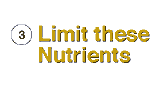
|
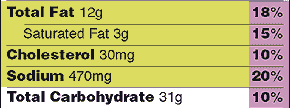
|
 |
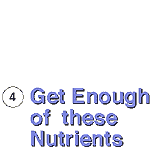
|
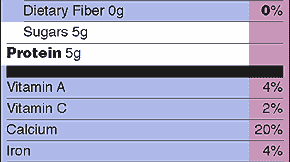
|
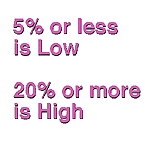
|
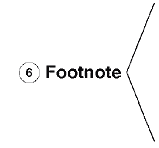
|
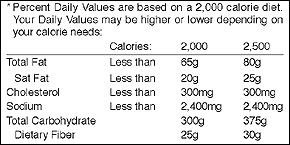
|
Know how to prepare, handle, and store food safely to keep you and your family safe:
Clean hands, food-contact surfaces, fruits, and vegetables. To avoid spreading bacteria to other foods, meat and poultry should not be washed or rinsed.
Separate raw, cooked, and ready-to-eat foods while shopping, preparing, or storing.
Cook meat, poultry, and fish to safe internal temperatures to kill micro organisms.
Chill perishable foods promptly and thaw foods properly.
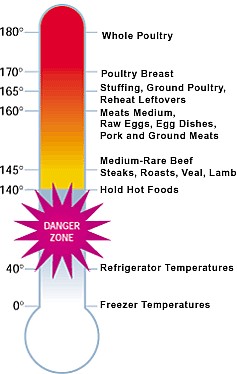
To convert to Centigrade, subtract 32 multiple by 0.56
If you choose to drink alcohol, do so in moderation. Moderate drinking means up to 1 drink a day for women and up to 2 drinks for men. Twelve ounces of regular beer, 5 ounces of wine, or 1 ounces of 80-proof distilled spirits count as a drink for purposes of explaining moderation. Remember that alcoholic beverages have calories but are low in nutritional value.
Generally, anything more than moderate drinking can be harmful to your health. And some people, or people in certain situations, shouldn't drink at all. If you have questions or concerns, talk to your doctor or healthcare provider.
These are the basic guidelines for eating a healthy diet and being physically active. Consult your doctor or nutritionist for a personalize diet plan for yourself.
Copyright © 2004
Irene Nursing Home Pte Ltd
|